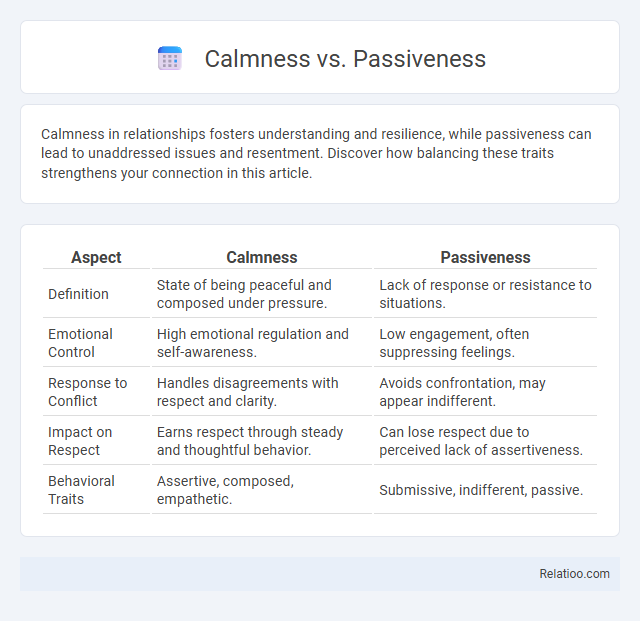Calmness in relationships fosters understanding and resilience, while passiveness can lead to unaddressed issues and resentment. Discover how balancing these traits strengthens your connection in this article.
Table of Comparison
| Aspect | Calmness | Passiveness |
|---|---|---|
| Definition | State of being peaceful and composed under pressure. | Lack of response or resistance to situations. |
| Emotional Control | High emotional regulation and self-awareness. | Low engagement, often suppressing feelings. |
| Response to Conflict | Handles disagreements with respect and clarity. | Avoids confrontation, may appear indifferent. |
| Impact on Respect | Earns respect through steady and thoughtful behavior. | Can lose respect due to perceived lack of assertiveness. |
| Behavioral Traits | Assertive, composed, empathetic. | Submissive, indifferent, passive. |
Understanding Calmness: Inner Peace Defined
Calmness represents a state of inner peace characterized by emotional stability and mindfulness, distinct from passiveness, which involves a lack of action or resignation. Understanding calmness involves recognizing deliberate control over reactions and maintaining composure despite external stressors. Achieving inner peace through calmness enhances mental clarity, resilience, and emotional balance.
What Is Passiveness? Traits and Tendencies
Passiveness refers to a tendency to avoid expressing opinions, feelings, or desires, often resulting in a lack of assertiveness and difficulty in setting personal boundaries. Traits of passiveness include hesitation to speak up, fear of conflict, and a reliance on others to make decisions, which can lead to feelings of frustration and resentment. Understanding your own passive behaviors enables you to develop healthier communication skills and assertiveness for balanced interactions.
Key Differences: Calmness vs Passiveness
Calmness involves maintaining inner peace and emotional control while actively engaging with situations, demonstrating resilience and thoughtful response. Passiveness, by contrast, reflects a lack of assertiveness or unwillingness to take action, often leading to avoidance or suppression of feelings. The key difference lies in calmness being an intentional and balanced state, whereas passiveness denotes inactivity or resignation.
The Benefits of Cultivating Calmness
Cultivating calmness enhances your mental clarity and emotional resilience, enabling better decision-making under pressure. Unlike passiveness, which may lead to inaction, calmness promotes proactive responses and balanced interactions. The benefits include reduced stress levels, improved focus, and stronger relationships through composed and thoughtful communication.
The Risks of Embracing Passiveness
Embracing passiveness often leads to missed opportunities and increased vulnerability, as it involves avoiding confrontation and decision-making, which can result in unresolved issues and growing frustration. Unlike calmness, which promotes thoughtful responses and emotional regulation, passiveness may cause stagnation and diminish personal growth. Understanding the distinction between calmness and passiveness is crucial to maintaining mental resilience and proactive problem-solving.
Signs You Are Calm, Not Passive
Recognizing signs you are calm, not passive, involves observing your ability to maintain composure while setting boundaries and asserting your needs respectfully. Calmness manifests through steady breathing, clear and confident communication, and thoughtful decision-making without aggression or withdrawal. Your balanced demeanor reflects inner strength, demonstrating control over emotions without disengaging from challenges or avoiding conflicts.
Calm Communication vs Passive Responses
Calm communication involves expressing your thoughts and emotions clearly with respect and composure, fostering understanding and effective problem-solving. Passive responses, in contrast, often involve withholding opinions or feelings, leading to unresolved issues and misinterpretations. Mastering calm communication empowers you to maintain assertiveness while promoting positive interactions without aggression or avoidance.
Strategies to Develop Calm Assertiveness
Calm assertiveness combines the tranquility of calmness with the confidence to express needs without passiveness or aggression. Effective strategies to develop this include practicing mindful breathing to maintain emotional control, setting clear personal boundaries to communicate expectations firmly, and engaging in role-playing exercises to build confidence in expressing opinions respectfully. Regular self-reflection on interactions enhances awareness of assertive behaviors while avoiding passivity or hostility.
Overcoming Passiveness for Personal Growth
Calmness embodies a composed and mindful state that fosters focused decision-making, while passiveness often leads to inaction and missed opportunities. Overcoming passiveness involves cultivating assertiveness and setting clear personal boundaries, which empowers you to take control of your growth journey. Prioritizing calmness with intention enhances your ability to respond thoughtfully, driving meaningful progress in your personal and professional life.
Choosing Calmness for Empowered Living
Choosing calmness over passiveness empowers your mind to respond thoughtfully rather than react impulsively, fostering emotional strength and resilience. Calmness enhances focus and clarity, enabling you to make deliberate decisions that align with your goals and values. Embracing calmness cultivates an empowered lifestyle where you maintain control over your actions and maintain inner peace amidst challenges.

Infographic: Calmness vs Passiveness
 relatioo.com
relatioo.com